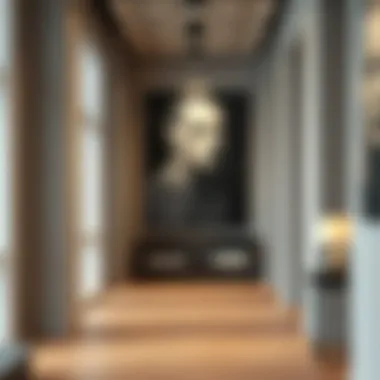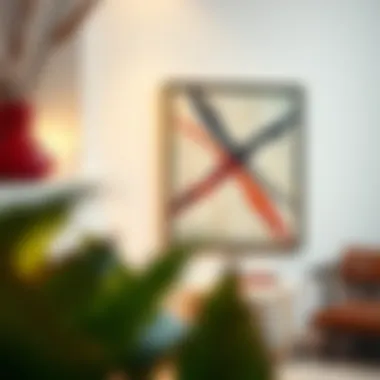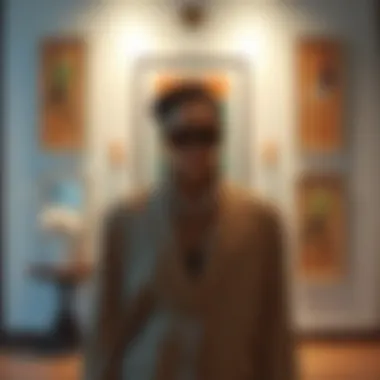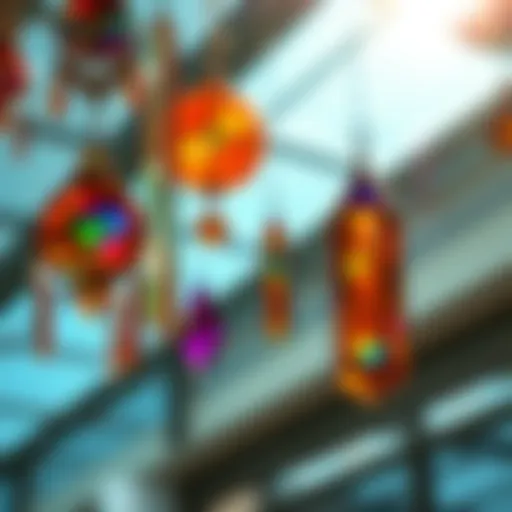The Impact of Wide and Narrow Wall Art on Interiors


Intro
Wall art plays an essential role in shaping the atmosphere of any space, but the dimensions and style of the pieces chosen can dramatically influence not only the aesthetic appeal but also the emotional experience of the inhabitants. Wide and narrow wall art serve different functions and evoke various feelings, making the choice between them pivotal for interior design.
Wide wall art often draws the eye, creating a sense of expansiveness in a room. They work wonders for making blank walls feel less intimidating while bridging designs across various decors. In contrast, narrow wall art tends to lend itself to a more focused viewpoint. It can create vertical lines that attract the gaze upward, often giving the illusion of higher ceilings and a more spacious feel.
This article intends to navigate through these contrasting dimensions of wall art. We'll explore their unique aesthetics, psychological effects, and practical applications within interior design. Each piece of art holds potential, and understanding how to effectively incorporate these into different settings can lead to transformative living spaces.
The subsequent discussions will provide insights that range from art selection to placement techniques, ensuring you have all the tools necessary to make informed choices. For the discerning reader, it’s pivotal to understand that the world of wall art extends beyond mere decoration. It is about creating an environment that resonates with personal style and emotional well-being.
Overall, it’s not just about what fills the walls; it’s about what fills the atmosphere with emotion and meaning.
Prelude to Wall Art Dimensions
Understanding wall art dimensions is crucial in creating a harmonious space that resonates with both aesthetics and functionality. The art you choose can dramatically alter a room's atmosphere and perception. Just like a custom-tailored suit that fits perfectly, the right wall art dimensions enhance your space and bring personal character or flair.
When decorating, attention to wall art shapes—whether wide or narrow—can make or break the ambiance. Wide wall art provides a sense of openness, filling larger wall spaces and creating a stunning centerpiece. Conversely, narrow wall art adds height and draws the eye upward, which is especially valuable in smaller rooms, making them feel more spacious than they are.
The benefits of understanding these dimensions extend beyond mere decoration. By exploring wall art dimensions, you can optimize functionality within a room. For instance, a wide painting sprawled across a large wall anchors the room, inviting focus and establishing a point of interest. On the other hand, a narrow piece, strategically placed, could lead viewers' gazes around the room, generating a narrative flow.
Designers, stylists, and homeowners can capitalize on these insights. Considering the area where you hang your pieces allows for more fundamental considerations like light, color balance, and emotional impact. The decision to choose between wide or narrow wall art hinges not only on personal tastes but also on the space’s constraints and desired effects.
"An art piece isn't merely decor; it shapes our feelings and interactions within a space."
In summary, wall art dimensions are more than numbers; they represent perspectives and experiences shaped by every viewer. Every inch counts, and accentuating the unique characteristics of your chosen dimensions can turn an ordinary wall into an extraordinary canvas of expression.
Visual Impact of Wide Wall Art
The visual impact of wide wall art can transform a space, giving it character and depth that narrow pieces often cannot achieve. This article section dives into how large-scale art serves not merely as decor but also as a foundational element in the design of a room. Its capacity to dominate a wall makes it an ideal focal point. When thoughtfully selected and placed, wide wall art can enhance the ambiance, influence the flow of a space, and even shift the emotional responses of those who enter. Importantly, understanding this impact can guide individuals—from designers to homeowners—in making informed decisions about their wall art choices.
Creating a Focal Point
Wide wall art inherently draws the eye, serving as a natural focal point that commands attention. Whether it’s a sweeping landscape, an abstract splash of colors, or a captivating visual narrative, these pieces can anchor a room’s design. For example, imagine entering a living room where a large canvas depicting a vivid sunset stretches across the wall. Instantly, it morphs from an empty space to an engaging experience, providing a conversation starter for guests and a subject of reflection for the homeowners.
To maximize the effect, it’s crucial to consider placement. Art hung at eye level typically has the most engaging effect. A common mistake is placing art too high, which can diminish its impact. Instead, keeping the bottom edge of the art around 57 to 60 inches from the floor tends to strike the right balance.
- Pro Tip: Utilize lighting to highlight the artwork. Soft spotlights or a gallery-style light can accentuate colors and textures, intensifying the emotional response it elicits.
Spatial Considerations in Design
Wide wall art is not just about aesthetics; it has significant functional implications in terms of spatial design. The size of the art can influence how a room feels. In larger areas, wide pieces can fill empty walls, pushing back the sensation of space and creating a more intimate atmosphere. A room that seems vast and hollow can become cozy and inviting through the strategic placement of expansive art pieces.
Conversely, when dealing with smaller rooms, careful consideration is needed. It’s a balancing act; too much large art can feel overwhelming while too little can seem lost in a space. Layering elements—combining wide wall art with smaller pieces—can often yield a harmonious visual experience. Hence, before committing to an artwork, assessing the room's dimensions and intended feeling is paramount.
- Consider this: Experiment with tape on the wall to visualize where an artwork will sit. It’s a simple trick that can save time and money while ensuring the piece has the desired impact.
Emotional Resonance of Large Scale Art
The emotional resonance of large-scale art goes beyond mere visual appeal. Art inspired by grand themes—nature, emotions, movement—can evoke a deeper connection. Studies indicate that people often respond to size; larger artworks can stimulate a sense of awe or wonder. Just think of a towering mural representing an urban landscape; it can transform a common corridor into a journey, offering residents and visitors a momentary escape.
Moreover, the right piece can encapsulate the spirit of a home. A wide, vibrant painting reflecting personal memories or aspirations might foster an environment filled with warmth or inspiration. People do not just view art; they live with it, and these large pieces often become part of their identity.
Visual Impact of Narrow Wall Art
Narrow wall art, often described as the silent backbone of interior decor, provides an avenue to use verticality in ways that wide artworks cannot. This aspect is crucial because it interacts with the dimensions of various rooms, emphasizes specific design elements, and enhances overall aesthetic appeal. Height becomes an asset when you draw attention vertically, and narrow wall pieces can change how a space is perceived, creating an illusion of taller ceilings or more substantial room proportions. Now, let's delve into the specific elements that make narrow art a worthwhile consideration in design choices.
Utilizing Vertical Space
Narrow wall art is a remarkable tool for maximizing vertical space, especially in homes that may feel cramped or limited. This type of art can draw the eye upward, creating the illusion of higher ceilings and a more expansive space. For instance, think about a long, slender piece that portrays a cascading waterfall or a series of abstract lines going from floor to ceiling. This not only adds height but also instills dynamism in an otherwise static space.
One might opt for several tall framed prints arranged in a line, such as a triptych of annual growth rings in a giant tree, which reinforces this verticality while adding texture and color. Arrange these pieces several inches apart to give them breathing space; this way, each piece can shine through without overwhelming the viewer.
Additionally, utilizing narrow art can create a sense of movement. Imagine placing a row of portraits or stretching canvases in a hallway — each step feels like a progression through curated history, engaging visitors and residents alike.
Enhancing Coziness in Smaller Rooms


Utilizing narrow art is particularly advantageous in smaller contexts. In tight living quarters, large pieces can often feel imposing, making a room seem even more smaller. In contrast, narrow wall art can soften the mood, transforming a compact space into a cozy sanctuary.
Consider this: If you have a small reading nook, a vertical piece of art can enhance the feel of intimacy rather than claustrophobia. A simple artwork like an elongated abstract portrait that has warm hues can create a welcoming ambiance, while imbuing the space with character.
Here’s the beauty of narrow wall art—it complements not just the spatial dimensions, but also the emotional tenor of a room. When hung strategically, the right piece can imbue even the tiniest of rooms with a sense of purpose and warmth, making them a refuge rather than a hindrance.
Creating a Gallery Wall Effect
Another fascinating element associated with narrow wall art is its compatibility with the gallery wall aesthetic. Creating a gallery wall doesn’t necessitate a sea of wide frames; in fact, mixing narrow pieces can lead to visually appealing outcomes.
Imagine dedicating a corner wall of your living room or hallway, where you layer narrow frames with diverse styles and colors—each telling its own story. Design enthusiasts can enjoy a blend of photographs, quotes, and textures that play off one another. This encourages viewers to explore and absorb the narrative you’re conveying through art.
By alternating the orientation of pieces—some vertical, some horizontal—you invite the viewer’s gaze to dance across the wall, creating visual interest and leading them on a journey. This strategy also allows designers to make a statement, without overwhelming a space—an essential balance when attempting to assert one’s taste in a modest area.
A well-curated gallery wall can turn the mundane into the extraordinary, igniting conversations and fostering connections through art.
In summary, narrow wall art is more than a stylistic choice; it is a practical solution that allows designers and homeowners alike to engage their living spaces in often overlooked ways. It enhancesvisual perceptions and emotional undertones in smaller areas, all while presenting an opportunity for creativity that speaks to individual aesthetics.
Artistic Styles Suited for Wide Formats
Choosing the right artistic style that complements wide wall formats is crucial for enhancing the overall aesthetic of a space. Wide art pieces can make a bold statement, filling your walls while adding character and depth. When considering wide wall art, various styles tend to shine, each with unique advantages and specific aesthetics that discourage a one-size-fits-all approach.
Several key points emerge when discussing wide formats. Firstly, they effectively capture attention, making them ideal for large spaces where they can function as a focal point. Secondly, the visual expansiveness of wide artwork can create a sense of harmony and balance in a room that contains multiple elements, from furniture to color schemes. Lastly, they provide an opportunity for greater storytelling through expansive visuals that draw viewers in.
Landscape Paintings and Photography
Landscape art often works well in wide formats, offering sweeping vistas and expansive scenes that truly come to life on larger canvases. These artworks can evoke feelings of openness, giving the impression of a continuous connection with nature. A sprawling landscape painting depicting majestic mountains or serene seascapes can inspire a sense of peace or adventure.
When placing such pieces, consider how the colors and themes in the art harmonize with existing decor. For instance, a tranquil blue sea can complement a soft beige sofa while bringing the space to life. Large landscape photographs are not just visually impressive; they also invite contemplation, encouraging viewers to lose themselves in the scenery.
"A great landscape artwork will not just decorate a room; it will transport you to another place and time."
Abstract Art and Its Appeal
Abstract art, with its bold shapes and colors, is another potent choice for wide formats. This style thrives on freedom of interpretation and can provoke various emotional responses. A large abstract piece can serve as a dynamic centerpiece, inviting viewers to engage their imagination.
One significant benefit of choosing abstract art is its ability to complement various interior design styles. Whether your space is minimalist, bohemian, or industrial, abstract art can adapt beautifully, integrating seamlessly into different environments. Its large scale has the power to define a space, acting as a conversation starter. Moreover, such bold strokes and colors can energize a room, breaking monotony with robust visual interest.
Mural Art and Installations
Mural art, whether painted directly onto walls or applied as wallpaper, represents one of the most impactful ways to utilize wide formats. These works not only fill space but also transform it, creating immersive environments that can tell a story or express an idea. Murals can turn a blank wall into a vibrant scene or a focal point by incorporating artistic elements directly into architectural designs.
Installation art offers flexibility in how an environment is experienced. Utilizing wide formats allows for multifaceted approaches, combining various materials and textures to create an engaging visual experience. Moreover, murals and installations often encourage interaction, sometimes prompting viewers to take photos or engage with the space in different ways.
Artistic Styles Suited for Narrow Formats
Choosing art for a narrow space often presents unique opportunities to create visual intrigue. Unlike wide formats, which can fill vast walls and demand attention, narrow wall art allows for more subtle, detailed compositions that can transform an area without overwhelming it. This section discusses artistic styles that excel in these vertical planes, encouraging an appreciation for verticality and design flexibility.
Portraits and Vertical Landscapes
Portraits signify a powerful artistic style suited for narrow formats. They often evoke emotion and tell stories through the expressions, gestures, and settings of their subjects. When placed in hallways or narrow living areas, portraits can guide the viewer's eye upwards or downwards, effectively utilizing the space to create a flow.
Vertical landscapes, on the other hand, capture the natural world in a format that stretches the viewer's perspective. Tall trees, narrow mountain paths, or cascading waterfalls all work well to create a serene environment, especially in smaller rooms. They inspire thoughts of exploration and adventure, becoming conversation starters, and inviting discussion about the mood they evoke.
"Portraits and vertical landscapes, when thoughtfully curated, can turn an ordinary wall into a storytelling canvas, enhancing the emotional landscape of a space."
Sculptural Wall Art
Sculptural wall art offers a tactile element that narrows in on the viewer's experience. These three-dimensional pieces can bring depth and richness, introducing a new texture to your wall decor. Materials such as metal, wood, or fabric can create dynamic interactions with light and shadow, reshaping how we perceive narrow spaces.
When hanging sculptural elements, consider arranging them at varying heights to mimic natural growth patterns. This not only draws attention but also emphasizes the vertical aspect of the wall. Whether it's a series of wooden layers resembling a forest or metal sculptures reflecting urban life, these artworks turn walls into vibrant landscapes.
Textual and Graphical Artworks
Textual and graphical art can often be overlooked when discussing narrow formats. Yet, these pieces possess an evocative language of their own. Quotes from famous writers, poems, or even abstract typography can make powerful statements. By laying words out vertically, the message becomes part of the wall’s architecture, making a bold impact without needing a large footprint.
Graphical elements such as line drawings or geometry are also excellent choices for long, narrow walls. They can enhance spatial perception, leading the eye along the art instead of simply stopping at a single point. Mixing styles within narrow formats, such as pairing text with graphics, can create a multifaceted visual narrative.


In essence, the consideration of artistic styles suited for narrow formats allows for an imaginative exploration of space. Selecting art that complements the dimensions of your walls can create an impactful aesthetic, proving that beauty can indeed flourish in the most slender of confines.
Choosing Between Wide and Narrow Wall Art
When it comes to wall art, choosing between wide and narrow formats isn’t merely a matter of preference; it’s a decision rooted in the interplay of aesthetics, functionality, and emotional resonance. Selecting the right style can transform an ordinary space into something that expresses personality and enhances the atmosphere of a room. Understanding the implications of each format is essential, as they each bring their unique strengths and challenges to the table.
Assessing Room Dimensions
Before making a choice, the first step is to take a good look at the dimensions of the room. Quite frankly, the size and layout of the space can dictate what type of wall art will work best. For instance, in a small room, narrow pieces can create an illusion of height, drawing the eye upward and making the space feel more expansive. Conversely, in a grand hall with high ceilings, wide art can wrap the walls in a cozy embrace, anchoring the space visually.
It’s worth considering the overall balance too. If there are many smaller, narrow artworks already present, the room might benefit from the scale of a wide piece to break the visual monotony. Making measurements might seem tedious, but it can save you the headache of mismatched styles down the line.
Understanding Personal Aesthetic Preferences
Next off, you have to engage with your own aesthetic preferences. The art you choose should resonate with your personal style and reflect who you are. Narrow wall art often leans towards the sleek and contemporary, making it ideal for minimalist and modern interiors. On the other hand, wide art can convey drama and vibrancy, perfect for someone who wants to make a statement.
Think about how different art styles make you feel. When you visualize your space, what images come to mind? Is it the expansive ocean views captured in a wide panoramic painting or a collection of delicate, vertically oriented portraits? Understanding your tastes will help narrow down the options significantly.
Considering the Function of the Space
Finally, the function of the space plays a crucial role in your decision. For example, in a home office where focus and productivity are key, narrow art pieces featuring soothing colors can enhance concentration without distracting from the work. In contrast, a living room designed for entertaining might benefit from a wide piece that serves as a conversation starter.
Also think about the vibe you want to cultivate. Cozy and welcoming? Go for narrow artworks that add layers without overwhelming. Want to evoke awe? A striking wide piece could draw everyone's attention.
Practical Tips for Displaying Wall Art
Displaying wall art correctly is crucial for maximizing its aesthetic and emotional impact. People often invest time, money, and emotional energy in selecting pieces that reflect their taste and personality. Getting the display right can transform a room, making it feel more cohesive and inviting. Whether it's wide or narrow art, how you hang it matters significantly. Here are some practical tips to enhance the experience of displaying wall art.
Optimal Heights for Hanging Art
Finding the right height for your art can make the difference between good and breathtaking. A common rule of thumb is to hang art at eye level. In general, this translates to around 57 to 60 inches from the floor. However, this can vary depending on factors like the size of the art and the average height of individuals who will regularly occupy the space.
- Standard Height: Aim for 57-60 inches for most artworks.
- Consider Room Use: If it’s a kid's room, hang art lower to inspire creativity.
- Layering Art: For large pieces, consider placing them slightly higher to create depth, especially if combined with smaller pieces below.
Also, don’t hesitate to practice with paper outlines on the wall to get a visual of how different heights affect the space.
Grouping Techniques for Wall Art
When displaying multiple pieces, grouping can create a unified look. This technique is about more than just squeezing stuff onto the wall; it’s about crafting a visual narrative. Grouping wall art can work wonders in adding character to both wide and narrow spaces. Here are some effective strategies:
- Gallery Wall: Arrange a variety of pieces, from various styles and sizes, within a defined area. This adds a personal touch.
- Consistent Spacing: Leave 2 to 5 inches between each piece to make grouping look intentional rather than chaotic.
- Theme-Based Grouping: Select art that follows a theme—color palettes, subject matter, or artistic styles. This helps maintain visual harmony.
Using these methods, you can give a striking look to any wall that feels stuck in the ordinary.
Integration into Existing Decor
One of the most rewarding aspects of wall art is its power to accentuate existing decor. It can complement colors, styles, and themes already present in a room. To seamlessly integrate art into your space, consider the following:
- Color Coordination: Use colors from your existing decor as a guide. Pull a shade from a couch or curtains and find artwork that echoes it.
- Style Sync: Match or contrast art styles with furniture. An abstract piece can add a modern touch to classic decor, or vintage artwork may beautifully enhance a contemporary space.
- Accessorizing: Coordinate smaller decor elements such as vases or sculptures with your wall art. Choose pieces that tie in colors or themes, creating an extended visual narrative.
Pay attention to how the art interacts with these elements to enrich the room's overall ambiance.
"Art is a constant source of inspiration. Integrating it thoughtfully into your home elevates both your decor and mood."
Challenges of Large Wall Art
When it comes to large wall art, the potential is vast, yet it comes with its own set of hurdles. While these expansive pieces can truly transform a space, making it feel vibrant and alive, one might find themselves scratching their head at the challenges associated with their use. This section aims to uncover the essential aspects worth considering, offering insights to navigate the complexities of incorporating sizable art in any interior design.
Balancing Art and Other Elements
Integrating large wall art requires a careful eye to maintain a harmonious balance with existing room elements. A massive piece can claim attention, but it shouldn't overshadow the overall design. The trick is in curating the effects of light, furniture arrangement, and color palettes.
- Consider proportions: Art should often play off the scale of its surroundings. Too big a piece can dwarf furniture, making the space feel cramped.
- Vary heights and textures: Utilize various elements in the room to divert focus, such as layered textiles or multilevel shelving units. This not only breaks the monotony but creates a visual rhythm.
Striking this balance ensures that each piece of art works in concert with its surroundings rather than standing alone.


Cost Considerations
No one can deny that large wall art can steepen the budget. The materials, frame, and even the artist's reputation can cause prices to skyrocket. Before splurging on that showpiece, one should evaluate their spendings.
- Material choices can greatly influence costs. Canvas might be budget-friendly, while metal or glass can be on the pricier side.
- Framing can also add to the price. Custom frames may be necessary for larger art and can come with a hefty price tag.
- Installation costs can sneak in as well, particularly if the art is heavy or requires special mounting techniques. Hiring professionals can significantly raise expenses.
Being clear on one's budget before pursuing large art pieces can help avoid buyer’s remorse later.
Transport and Installation Issues
The road from purchase to display can be a bumpy one when it comes to large wall art. Transporting such sizable pieces can pose logistical nightmares if not planned properly. One must consider:
- Dimension surprises: Always take measurements of the artwork and your space to ensure it fits without a hitch.
- Transport logistics: You'll want to ensure safe handling during transport, whether it's a DIY effort or a delivery service. Big art can be fragile, and one mishap can lead to damages.
- Installation challenges: Not only does the piece require proper anchoring, but if it’s large and heavy, you might need additional tools or professionals for the installation process.
Consider seeking advice from those with experience or research online resources, like reddit.com, for real-life tips on managing these challenges.
Challenges of Narrow Wall Art
When discussing wall art, it is essential to consider the challenges that narrow formats present. These pieces often have a unique charm, yet their specific dimensions can lead to complications that are sometimes overlooked in discussions about aesthetics.
One of the prominent issues we’ll delve into is how narrow art can impact the overall feel of a space, particularly in larger settings. Also, we need to pay attention to how they can present difficulties in maintaining thematic consistency. Finally, concerns about fragility and risks of damage are pertinent when considering narrower works of art. Therefore, understanding these challenges is crucial for anyone looking to invest in or display narrow wall art.
Limited Impact in Large Spaces
Narrow wall art, by its very nature, can sometimes struggle to make a statement in expansive rooms. Imagine a large living room with high ceilings and vast walls adorned only by slender pieces. While these works can exude elegance, they often get lost amidst the surrounding space. A narrow painting or framed photo may not catch the eye the same way a wide piece might.
This subtlety may appeal to some, but in larger environments, it may lead to a sense of imbalance. Here are some considerations regarding the use of narrow art in grand settings:
- Integration with Other Elements: When narrow pieces are used, they may need to compete for attention with other decor elements, such as furniture or wide art pieces.
- Multiple Pieces: To enhance impact, one might consider grouping multiple narrow artworks together. However, this can lead to a cluttered or chaotic look—something that designers often aim to avoid.
- Framing Choices: The frame can play a significant role; it is often beneficial to choose a bold frame to provide some contrast to the thinness of the art.
Ultimately, while narrow art can do wonders for the right setting, it requires careful thought in larger spaces to ensure it does not fade into the background.
Difficulties in Thematic Consistency
Establishing a cohesive theme is often a designer’s goal, yet narrow wall art may present challenges in maintaining that desired consistency. When mixed with different styles or sizes, narrow pieces can appear out of place. For instance, towering portraits may not harmonize with expansive abstracts if not thoughtfully positioned.
This aspect can become particularly complex in shared spaces like living or dining areas, which might accommodate various tastes and styles of art. To navigate these waters, here are a few suggestions:
- Stick to a Theme: Choosing narrow art that complements the overarching theme of the room can provide cohesion. For example, an abstract narrow painting can have the same color palette as broader pieces nearby.
- Color Consistency: Use color as a tool to tie together different art formats. Perhaps a narrow piece in subtle shades can link wider pieces with bold colors, creating a balanced flow.
- Mixed Media: Integrating different types of media, like textiles or metallics in narrow formats, can provide texture that uniquely adds depth to the overall theme.
Fragility and Damage Risks
Narrow wall art, often more delicate compared to larger counterparts, can be prone to damage. This vulnerability poses questions about placement and care.
For instance, think about a narrow watercolor piece that might be perfect for a cozy hallway but less ideal for a high-traffic area. Here are some considerations regarding fragility:
- Material Sensitivity: Artists often use fragile materials for narrow pieces, such as light paper or canvas. This makes them susceptible to wear and water damage.
- Placement: It’s crucial to think about where to hang narrow artworks. Areas with less foot traffic can prolong the piece’s lifespan.
- Protective Measures: Consider acrylic barriers or frames with glass to shield delicate pieces from dust and accidental contact.
Overall, while narrow wall art offers unique decorative opportunities, it is essential to be mindful of the challenges they present in both aesthetic and practical terms.
Final Thoughts on Wall Art Selection
When it comes to wall art, selecting the perfect piece isn't just about aesthetics; it's about creating a connection with your space. This section dives into why the choices we make about wall art can be crucial for defining a room's vibe. Understanding the nuance between wide and narrow formats allows for a more tailored and effective approach to interior design, resulting in an environment that resonates personally and visually.
Evolving Personal Taste Over Time
Art has a way of reflecting personal journeys. As individuals grow, so do their preferences. What once seemed essential can feel out of place after a few months or years. It's not unusual to find that pieces which once captured the heart may lose their appeal. Hence, recognizing that wall art can and should evolve with you is key.
- Focus on selecting pieces that speak to various chapters of your life. Whether it’s an abstract painting that stirred something in you during a particular phase or a photograph that captures a meaningful place, these elements weave into the story of who you are.
- Consider rotating artworks or investing in smaller, more interchangeable pieces. This flexibility allows your space to reflect your current tastes without the burden of costly replacements.
- Remember that art can surprise you; revisit older pieces periodically. Sometimes, the context of memories attached to certain works can rekindle appreciation that feels fresh.
Art as an Ongoing Conversation
Art extends beyond being a mere decorative element—it's a dialogue. Each piece brings not only its own history but can provoke thoughts, feelings, and interactions among those who encounter it. Wall art presents a unique opportunity to engage with guests, or even with yourself, through reflective conversation.
- Think about the narrative each artwork presents. Consider a bold piece that sparks discussion or questions about its meaning. Such elements can bridge gaps in conversations, turning an ordinary gathering into a more profound experience.
- Supporting local artists or your friends who create can deepen these conversations. Not only does it add a personal touch to your decor, but it also supports community and individual stories.
- Actively seeking to change the art in your space can provoke new discussions or perspectives, both for you and your visitors. Movement and change breathe new life into conversations and perspectives.
The Enduring Influence of Wall Art on Emotion and Space
Art doesn't merely fill walls; it shapes moods and alters perceptions. The types of wall art selected can dramatically affect the ambience of a room, whether calming or energizing. Recognizing these influences equips anyone with the ability to curate a personal haven that resonates deeply.
- Consider how colors, forms, and themes evoke different emotions. A wide abstract piece might inspire calm and tranquility, while vibrant figurative art could inject energy into the environment.
- Think about the purpose of the space. A calming piece in a bedroom can promote serenity, while lively images in a living room can encourage conversation and warmth. Aligning art with function ensures spaces serve their best purpose.
- Take note of how your emotional state shifts with different pieces. Keeping a log or journal related to your art can help track how certain images influence you over time, informing future selections.
Art, in any form, is a manifestation of life experiences and emotions. It invites us to reflect, to engage, and perhaps most importantly, to connect with ourselves and others in more profound ways.















